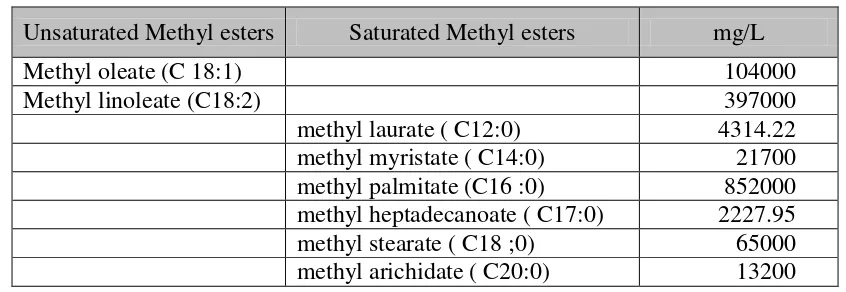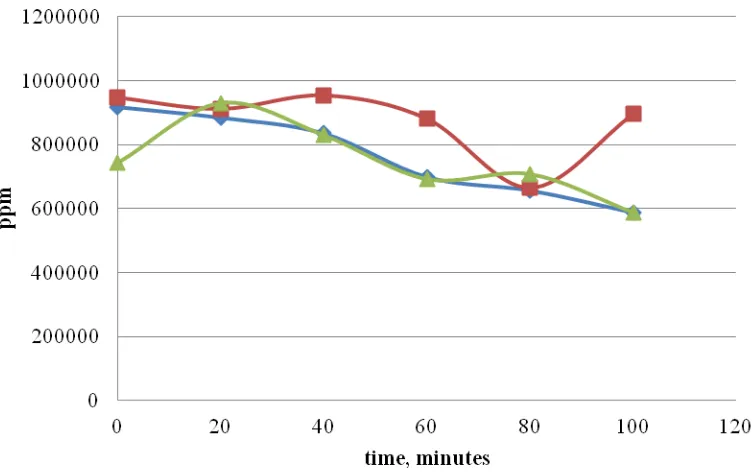SYNTHESIS OF BIODIESEL FROM WASTE COOKING OIL BY TWO
STEPS PROCESS TRANSESTERIFICATION AND OZONATION
Lieke Riadi1,2, Aloysius Yuli Widianto1, Edy Purwanto1,Akso Pono1, Ruth Theresia1
1)
Chemical Engineering Department, The University of Surabaya. Jl.Raya Kalirungkut .Surabaya.60239
2)
Center For Environmental Studies, The University of Surabaya. Jl.Raya Kalirungkut .Surabaya.60239 Email: [email protected], [email protected]
ABSTRACT
The synthesis of biodiesel has been widely studied. There are many raw materials used for the synthesis either from edible or non-edible oil. In this study, we investigated the synthesis of biodiesel using two steps process. The synthesis at 60 oC and ozonation are running in consecutive ways. The waste cooking oil was prepared for synthesis at 60 oC for one hour. The mol ratio of waste cooking oil and methanol was 1 : 5 and 1.5 % w/w NaOH was used as catalyst. The reaction involved in the synthesis is transesterification, the product was collected and then will be processed for ozonation. The ozonation was carried out at 20 oC for 2 hours with mol ratio of methanol to transesterification product was 7 : 1. The acid catalyst ( H2SO4) was used for 1.5 % w/w and 2 % w/w. Sample from both synthesis at 60 oC and ozonation process have been analysed using Gas Chromatography. The composition of fatty acids ( % w/w ) in waste cooking oil used for the experiment were : lauric acid 0.34 % ; myristate acid 1.32 % ; palmitic acid 38.7 %, stearic acid 4.67 %, oleic acid 40.1 %, linoleic acid 12.7 % and others 2.17 %. It has been proved that transesterification product from synthesis at 60oC contained of long chain methyl esters, hence the reaction is esterification from long chain fatty acids to long chain methyl esters which consisted of saturated and unsaturated methyl esters. The dominants long chain methyl esters from synthesis at 60 oC were methyl palmitate, methyl oleat, methyl stearate. Other long chain methyl esters are Methyl laurate, Methyl myristate, Methyl pentadecanoate, Methyl palmitoleate, Methyl linoleate, Methyl heneicosanoate, and Methyl heptadecanoate. There were three unsaturated methyl esters have been produced which are methyl palmitoleate, methyl oleat and methyl linoleate. All these products were then ozonised by ozonation process at various temperature. Short chain methyl esters which were from cracking of unsaturated methyl esters and long chain methyl esters remained as product . The transesterification can occur though it is only running at 10, 20 and 30 o
C. The short chain methyl esters are methyl nonanoate, methyl hexanoate, and methyl octanoate. Methyl nonanoate was a product from cracking of methyl oleate, whereas methyl hexanoate was a product of cracking of methyl linoleate .It was found that the best temperature used for ozonation was 20 oC.
Keywords : transesterification, ozonolysis, long chain methyl esters, short chain methyl esters, two steps process.
INTRODUCTION
diesel engines and is the first alternative fuel to commercial diesel which has a thoroughly evaluation of emission results. There were many studies in producing biodiesel from soybean, palm and rapeseed oils (Demirbas, 2009). However, there was no study in biodiesel production from waste cooking oils by either ozonation or two steps process which combined transesterification and ozonation. Waste cooking oil was used in this study, since there were many fatty acids in the waste cooking oils used in the study, which were lauric acid 0.34 % ; myristate acid 1.32 % ; palmitic acid 38.7 %, stearic acid 4.67 %, oleic acid 40.1 %, linoleic acid 12.7 % and others 2.17 % ( Riadi,et.al
2013). It will also reduce the problem of waste cooking oils in the disposal area. Moreover, the combustion of biodiesel does not increase the level of carbon dioxide in the atmosphere, since the oil returns carbon dioxide obtained earlier from the atmosphere via photosynthesis, which is then known that biodiesel is carbon neutral (Ong and Bhatia, 2010). The objective of this paper is to assess the production of long chain, short chain methyl esters in the two steps process used in biodiesel synthesis at different temperature and catalyst concentration. Ozone is known as strong oxidative agent, and known to react with double bonds in fatty acids to form intermediate products yield aldehydes, acetal and then formed methyl esters.
MATERIALS AND METHODS
2.1. Materials
Waste cooking oil from fast food restaurants, Methanol 96 %, Potassium iodide, Magnesium sulphate anhydrate, Potassium Hydroxide and Sodium Carbonate were supplied from Merck, Oxygen gas was purchase from Aneka Gas Industry.
2.2. Experiment
2.2.1 Synthesis at 60 oC ( transesterification)
Waste cooking oil and methanol with mol ratio 1 : 5 were poured into 2 L glass reactor equipped with a cooling system, stirrer, tube sparger and thermocouple. A 1.5 weight % of NaOH was added to the reactor. The experiment was run for 1 hour at 60 oC with agitation speed of 450 rpm. After one hour of experiment, sample was treated for separation between biodiesel and methanol, purified by removing water. Sample was then analysed for methyl esters and intermediates using GC (Gas Chromatography).
2.2.2. Ozonation
The product resulted from synthesis at 60 oC was mixed with methanol with mol ratio of 1:7 and poured in a 2 L stainless steel reactor equipped with a cooling system, stirrer, tube sparger and thermocouple. Each of 1.5 % and 2 % weight of sulfuric acid were added as catalyst. Ozone was produced from oxygen gas using VIRESCO ozone generator (Singapore). The ozone concentration in the feed was maintained about 5.8 mol % at certain flow rate. The reactor outlet was connected to a potassium iodide solution trap hence excess ozone was decomposed. The reaction was run at 20 o
C, 450 rpm agitation. Samples were taken every 20 minutes. After the reaction run for 2 hours, the ozone gas was shut off, the reaction products in the reactor were flushed for 10 minutes with oxygen to remove the excess of ozone.. Each sample taken was separated using funnel filter to get the biodiesel. The biodiesel was then washed with warm water to remove catalyst and also side product. Water remained in the product was removed by MgSO4, anhydrate, and the biodiesel was analyzed using GC (Gas Chromatography).
2.2 .3. Assays
for 2 minutes, increased to 200 oC at rate of 10 oC/min and hold for 4 minutes, it is then raised to 240 oC at rate 5 oC/min and hold for 7 minutes. Temperatures of the injector and detector were 275 o
C and 200 oC respectively. Split injection was used at a sample size of 1.0 μl.
RESULTS AND DISCUSSIONS
3.1. Biodiesel Synthesis at 60 oC
Waste cooking oils used in this experiment consisted of unsaturated and saturated fatty acids. The biodiesel synthesis at 60 oC ( transesterification) was designed to synthesis fatty acids and form methyl esters. Methyl esters formed from the experiment is presented in Table 1. The dominant methyl esters resulted from the synthesis were methyl palmitate, oleat and stearate. It is similar with the composition of waste cooking oil which is dominated by palmitic, stearic and oleic acids. There were two unsaturated methyl esters produced from this process, methyl oleate and methyl linoleate. The saturated methyl esters produced form this process were methyl laurate, methyl myristate, methyl palmitate, methyl heptadecanoate, methyl stearate, methyl arichidate. The unsaturated methyl esters produced was 34.33% , whereas the saturated methyl esters produced was 65.67 % This result showed that transesterification process produced methyl esters without intermediates.
Table 1. Methyl esters from synthesis at 60 oC ( transesterification)
Unsaturated Methyl esters Saturated Methyl esters mg/L
Methyl oleate (C 18:1) 104000 and methyl nonanoate. Other fragments from cracking process was predicted as dimethyl azelate and dimethyl malonate as can be seen at Table 2. (Baber et.al, 2005).
Table 2. Fragments produced from cracking of unsaturated methyl esters
Unsaturated Methyl esters Fragments of short chain methyl esters & dimethyl esters
Methyl oleate (C 18:1) Methyl nonanoate Dimethyl azelate
Methyl linoleate (C18:2) Dimethyl malonate Methyl hexanoate Dimethyl
azelate
continually produced during the ozonation, however long chain methyl esters which have been formed during transesterification were decrease during ozonation. This result will be explained in section 2.3.
3.3. Effect of temperature in Ozonation Process
The total short chain methyl esters (SCMEs) produced from ozonation increased with time of reaction, both for 1.5 % and 2 % acid catalyst as can be seen at Figure 1 and 2. The highest value of total short chain methyl esters was at 20 oC . However, the total long chain methyl esters (LCMEs) were decreased during ozonation process as can be seen at Figure 3 and 4. It is proved that ozonation process consisted of transesterification and ozonolysis. The transesterification occurs as a simultaneous reaction with ozonolysis though the experiments were carried out at 10 oC , 20 oC and 30 oC. We assumed that the decrease of long chain methyl esters was due to reverse reaction as a result of backwards reaction of transesterification (Pahola, et.al, 2013). Hence, we need to stop the ozonation process prior 2 hours completion of experiment.
Figure 2. Total SCME at different temperature ozonation (Δ 30oC, □20oC, ◊10oC), 2 % acid catalyst
Figure 4. Total LCME at different temperature ozonation (Δ 30oC, □20oC, ◊10o
C), 2 % acid catalyst
The total methyl esters produced from first step experiment was 1.4 E+06 ppm where as the total methyl esters produced after the ozonation process was 1.2 E+06 ppm which was carried out after 100 minutes. To prevent big loss of methyl esters, we suggest to stop the ozonation process at 40 minutes, which can result in total methyl esters of 2.1 E+06 ppm. The kinematic viscosity of the product at different temperature can be seen at Table 3.The viscosity is match with the viscosity of biodiesel standard (2.3- 6 cSt)
Table 3 The Kinematic viscosity of the product at different temperature
Kinematic viscosity Temperature
10 oC 20 oC 30 oC
Kinematic viscosity Products of
Ozonation using 1.5 % catalyst (cSt) 3.13 3.21 3.028
Kinematic viscosity Products of
Ozonation using 2% catalyst (cSt) 3.14 3.65 3.31
CONCLUSION
The best operation condition for ozonation after transesterification (60 oC ) was at 20 oC using either 1.5 % or 2 % catalyst. To avoid losses of Long chain methyl esters, the ozonation process is suggested to stop at 40 minutes of experiment. Short chain methyl esters and dimethyl esters have been produced as fragments from doubled bond cracking of unsaturated methyl esters due to the ozonolysis. There were losses of long chain methyl esters which have been produced for the step process due to reverse reaction of transesterification in the ozonation process.
Acknowledgement
REFERENCES
[1] Baber, T.M, Gravier,D,Lira,CT and Narayan, R. (2005). Application of catalytic Ozone Chemistry for improving Biodiesel Product Performance. Biomacromolecules, 1334-1344.
[2] Demirbas, A. (2009) Progress and recent trends in biodiesel fuels.Energy Conversion and management, 50 , 14-34.
[3] Frankel, E.N., Neff, W.E. , Selke E. and Brooks, D.D. (1987)
Thermal and Metal-Catalyzed Decomposition of Methyl Linolenate Hydroperoxides. LIPIDS, Voi. 22, No. 5, 322-326.
[4] Pahola, T.B, Salazar, J., Diwekar,U.(2013) Economic Comparison of Continuous and Batch Production of Biodiesel using Soybean Oil, Environmental Progress and Sustainable Energy.; 31 no.1, 11-24.
[5] Riadi, Lieke and Lie, Hwa and Purwanto, Edy and Widianto, Aloysius Yuli (2013) Pengaruh Suhu dan kecepatan pengaduk pada reaksi Ozonolysis dan Transesterifikasi Minyak Goreng Bekas.

